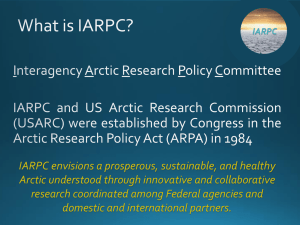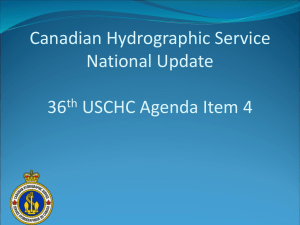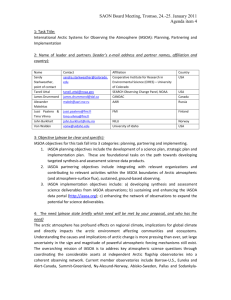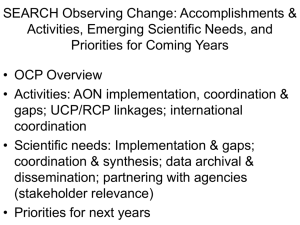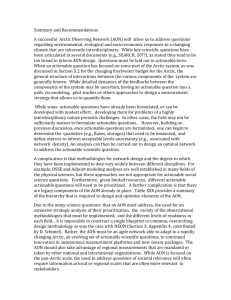Helen`s first draft list of activities from Tuesday afternoon (revised)
advertisement
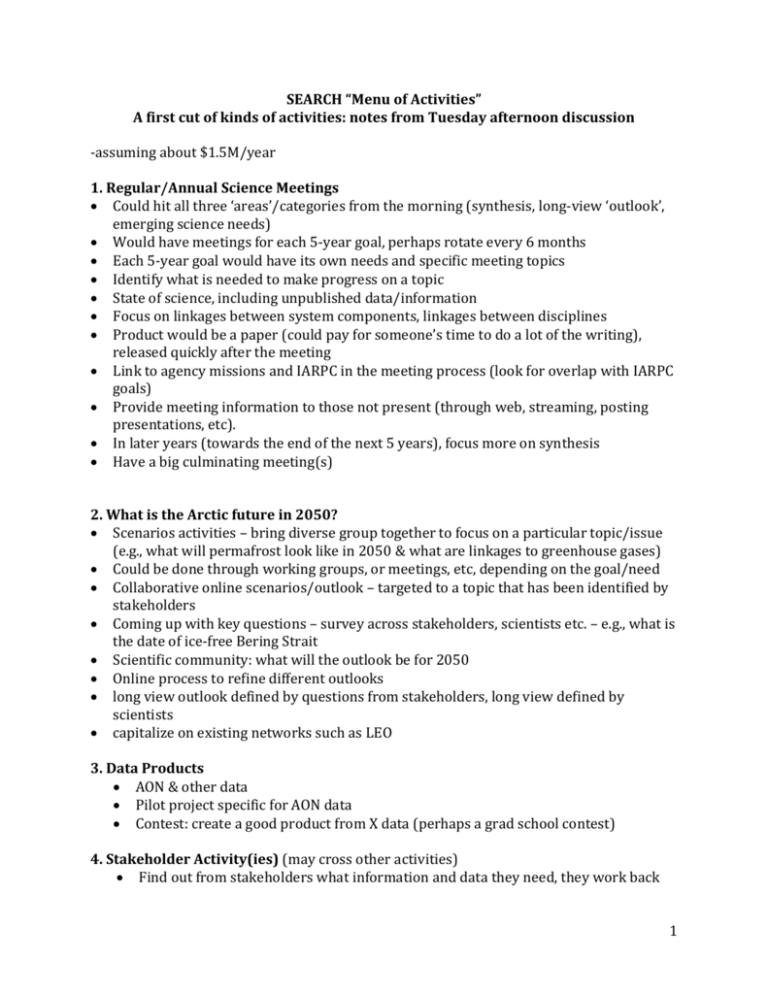
SEARCH “Menu of Activities” A first cut of kinds of activities: notes from Tuesday afternoon discussion -assuming about $1.5M/year 1. Regular/Annual Science Meetings Could hit all three ‘areas’/categories from the morning (synthesis, long-view ‘outlook’, emerging science needs) Would have meetings for each 5-year goal, perhaps rotate every 6 months Each 5-year goal would have its own needs and specific meeting topics Identify what is needed to make progress on a topic State of science, including unpublished data/information Focus on linkages between system components, linkages between disciplines Product would be a paper (could pay for someone’s time to do a lot of the writing), released quickly after the meeting Link to agency missions and IARPC in the meeting process (look for overlap with IARPC goals) Provide meeting information to those not present (through web, streaming, posting presentations, etc). In later years (towards the end of the next 5 years), focus more on synthesis Have a big culminating meeting(s) 2. What is the Arctic future in 2050? Scenarios activities – bring diverse group together to focus on a particular topic/issue (e.g., what will permafrost look like in 2050 & what are linkages to greenhouse gases) Could be done through working groups, or meetings, etc, depending on the goal/need Collaborative online scenarios/outlook – targeted to a topic that has been identified by stakeholders Coming up with key questions – survey across stakeholders, scientists etc. – e.g., what is the date of ice-free Bering Strait Scientific community: what will the outlook be for 2050 Online process to refine different outlooks long view outlook defined by questions from stakeholders, long view defined by scientists capitalize on existing networks such as LEO 3. Data Products AON & other data Pilot project specific for AON data Contest: create a good product from X data (perhaps a grad school contest) 4. Stakeholder Activity(ies) (may cross other activities) Find out from stakeholders what information and data they need, they work back 1 from there 5. Citizen Science Local communities want to know how best to collect data – need tools/guidance for measuring aspects of arctic change (e.g., erosion) 6. Exchange/visiting scientist Fellowship where a scientist gets immersed (e.g., for a few or several months) in an agency/department where they are dealing with decision-making (e.g., regulations, etc.) Or exchange could be the other way Provided through ‘micro-grants’ Could be young scientist (with mentoring) Some exchanges could be determined by the SSC, others through an application process 7. Newsletter, blog, communication And broader communications strategy Ask users what type of information is needed Audiences would include agencies & scientific community 8. “High-level” Communications science office rep/interface with IARPC, USARC, Arctic Council interface with Congress DC based person 9. “SEARCH for answers!” SEARCH as a think tank. Similar to how agencies approach the PRB, but arctic, smaller/more focused. Have a process that allows for response/answers to queries. e.g, where will ice be concentrated? 10. Value-added Arctic Report Card implications: focus on SEARCH goals & themes regional perspective; cross-sector implications get feedback from report card team on what would greatly enhance the product This would also showcase how SEARCH can act as a think tank (see #9 above) 11. Networking Including the work needed to ensure meetings, working groups, etc have broad representation. Multi-disciplinary science, agencies, stakeholders, etc – as appropriate. (this can be a full time job) Assessing current networking and who participates in various activities, then go a step further and do an analysis on how networking can be improved (social science projects), and how connections have changed (improved?) over time Including relationship-building activity and how to build trust 2 Networking tools (databases, ‘match.com’ for arctic science, etc.) Include industry Possible ways to engage industry may include: Working with agencies on research topics that may be beneficial from a regulatory standpoint (may spur some industry research funding based on regulatory needs to understand the system; need to be careful to maintain valueneutral position) Science-based internships in industry positions 12. Town Hall Science Scientist who communicates well, 2-way interaction, ‘Citizen Science’, participatory activities, help villages, synthesize this, guidance documents for taking measurements by citizen scientists. Take this to schools. Communication/ outreach activities for Arctic science could also extend to the lower 48 to increase Arctic awareness outside of local stakeholder groups 13. Synthesis activity Start with a blank slate so the people who are there feel like they are contributing to developing a synthesis Get disparate groups together at the table to develop the synthesis, Military and industry High-level synthesis, uber-synthesis, what would be the usefulness of this? Bring in broader group of voices to the table, for example: Information architecture expert on data management issues Clifford Lynch. Synthesis has to be focused on a specific problem. 14. Emerging Issues Get the right people together and the ideas will come out. We should get this from a later session of our meetings. Invitation to core, then open up with application process ‘what will you contribute to this process?’ To prioritize may take several rounds to end up with the priority list. Priority has to be an objective and everyone has opportunity to have their voice, but you may not listen to people. Doors open again for revisiting. Carried over from the morning: Unresolved 'activity area': "Coordinate Research " didn't come to agreement on this in the morning's discussion What does or doesn't the SSC need to do here? Does SEARCH coordinate research efforts as an activity? What about AON & coordinating observations? We will need to be very specific as far as what everyone means when we say 'coordination'. To one person it could mean providing a website where observing activities are tracked. To another it could mean charging a group to have a workshop/white paper that comes up with priority observations, which is given to 3 funding agencies. To another it could be working with groups to plan future field campaigns. To another it could just be talking to various groups to help link together efforts. To another it could be something else entirely. 4




